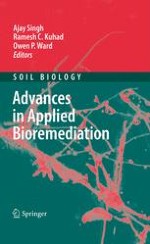
2009 | OriginalPaper | Buchkapitel
1. Biological Remediation of Soil: An Overview of Global Market and Available Technologies
verfasst von : Ajay Singh, Ramesh C. Kuhad, Owen P. Ward
Erschienen in: Advances in Applied Bioremediation
Verlag: Springer Berlin Heidelberg
Aktivieren Sie unsere intelligente Suche, um passende Fachinhalte oder Patente zu finden.
Wählen Sie Textabschnitte aus um mit Künstlicher Intelligenz passenden Patente zu finden. powered by
Markieren Sie Textabschnitte, um KI-gestützt weitere passende Inhalte zu finden. powered by